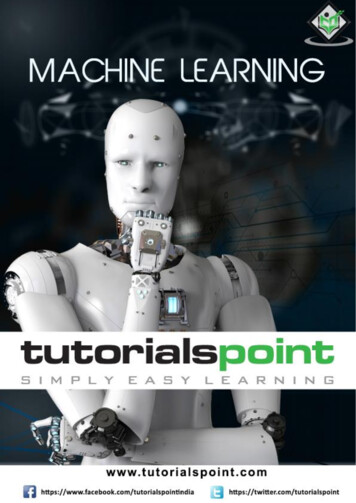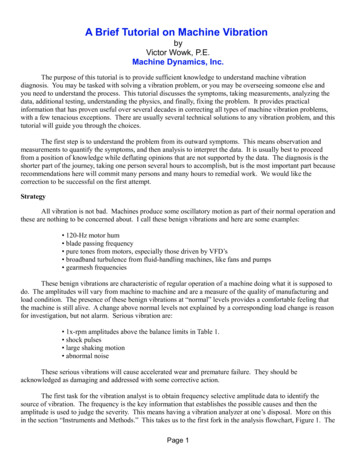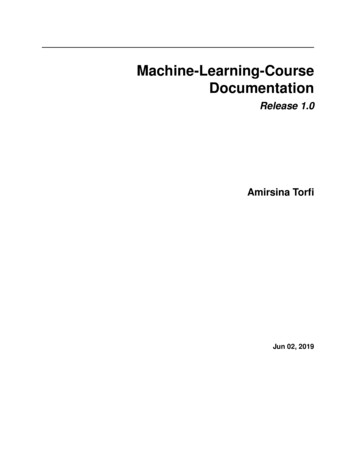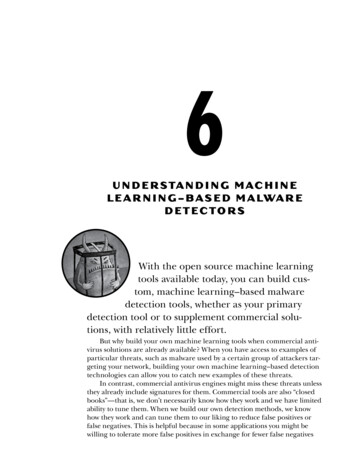
Transcription
i
About the TutorialToday’s Artificial Intelligence (AI) has far surpassed the hype of blockchain and quantumcomputing. The developers now take advantage of this in creating new Machine Learningmodels and to re-train the existing models for better performance and results.This tutorial will give an introduction to machine learning and its implementation inArtificial Intelligence.AudienceThis tutorial has been prepared for professionals aspiring to learn the complete picture ofmachine learning and artificial intelligence.This tutorial caters the learning needs of both the novice learners and experts, to helpthem understand the concepts and implementation of artificial intelligence.PrerequisitesThe learners of this tutorial are expected to know the basics of Python programming.Besides, they need to have a solid understanding of computer programing andfundamentals.If you are new to this arena, we suggest you pick up tutorials based on these conceptsfirst, before you embark on with Machine Learning.Copyright & Disclaimer@Copyright 2019 by Tutorials Point (I) Pvt. Ltd.All the content and graphics published in this e-book are the property of Tutorials Point (I)Pvt. Ltd. The user of this e-book is prohibited to reuse, retain, copy, distribute or republishany contents or a part of contents of this e-book in any manner without written consentof the publisher.We strive to update the contents of our website and tutorials as timely and as precisely aspossible, however, the contents may contain inaccuracies or errors. Tutorials Point (I) Pvt.Ltd. provides no guarantee regarding the accuracy, timeliness or completeness of ourwebsite or its contents including this tutorial. If you discover any errors on our website orin this tutorial, please notify us at contact@tutorialspoint.comi
Machine LearningTable of ContentsAbout the Tutorial . iAudience. iPrerequisites . iCopyright & Disclaimer . iTable of Contents. ii1.MACHINE LEARNING – INTRODUCTION . 12.MACHINE LEARNING – WHAT TODAY’S AI CAN DO? . 2Example . 23.MACHINE LEARNING – TRADITIONAL AI . 3Statistical Techniques . 34.MACHINE LEARNING – WHAT IS MACHINE LEARNING?. 45.MACHINE LEARNING – CATEGORIES OF MACHINE LEARNING . 6Supervised Learning . 7Unsupervised Learning . 8Reinforcement Learning. 9Deep Learning . 10Deep Reinforcement Learning . 106.MACHINE LEARNING – SUPERVISED LEARNING . 11Algorithms for Supervised Learning . 11k-Nearest Neighbours . 11Decision Trees. 13Naive Bayes . 14ii
Machine LearningLogistic Regression . 14Support Vector Machines . 157.MACHINE LEARNING – SCIKIT-LEARN ALGORITHM . 168.MACHINE LEARNING – UNSUPERVISED LEARNING . 17Algorithms for Unsupervised Learning . 179.MACHINE LEARNING – ARTIFICIAL NEURAL NETWORKS . 19ANN Architectures . 2010.MACHINE LEARNING – DEEP LEARNING . 22Applications . 22Untapped Opportunities of Deep Learning . 22What is Required for Achieving More Using Deep Learning? . 23Deep Learning - Disadvantages . 2311.MACHINE LEARNING – SKILLS FOR MACHINE LEARNING . 26Necessity of Various Skills of Machine Learning . 2612.MACHINE LEARNING – IMPLEMENTING MACHINE LEARNING . 29Language Choice . 29IDEs. 29Platforms . 3013.MACHINE LEARNING – CONCLUSION . 31iii
1. Machine Learning – IntroductionToday’s Artificial Intelligence (AI) has far surpassed the hype of blockchain and quantumcomputing. This is due to the fact that huge computing resources are easily available tothe common man. The developers now take advantage of this in creating new MachineLearning models and to re-train the existing models for better performance and results.The easy availability of High Performance Computing (HPC) has resulted in a suddenincreased demand for IT professionals having Machine Learning skills.In this tutorial, you will learn in detail about:What is the crux of machine learning? What are the different types in machine learning? What are the different algorithms available for developing machine learningmodels? What tools are available for developing these models? What are the programming language choices? What platforms support development and deployment of Machine Learningapplications? What IDEs (Integrated Development Environment) are available? How to quickly upgrade your skills in this important area?1
2. Machine Learning – What Today’s AI Can Do?Machine LearningWhen you tag a face in a Facebook photo, it is AI that is running behind the scenes andidentifying faces in a picture. Face tagging is now omnipresent in several applications thatdisplay pictures with human faces. Why just human faces? There are several applicationsthat detect objects such as cats, dogs, bottles, cars, etc. We have autonomous carsrunning on our roads that detect objects in real time to steer the car. When you travel,you use Google Directions to learn the real-time traffic situations and follow the best pathsuggested by Google at that point of time. This is yet another implementation of objectdetection technique in real time.Let us consider the example of Google Translate application that we typically use whilevisiting foreign countries. Google’s online translator app on your mobile helps youcommunicate with the local people speaking a language that is foreign to you.There are several applications of AI that we use practically today. In fact, each one of ususe AI in many parts of our lives, even without our knowledge. Today’s AI can performextremely complex jobs with a great accuracy and speed. Let us discuss an example ofcomplex task to understand what capabilities are expected in an AI application that youwould be developing today for your clients.ExampleWe all use Google Directions during our trip anywhere in the city for a daily commute oreven for inter-city travels. Google Directions application suggests the fastest path to ourdestination at that time instance. When we follow this path, we have observed that Googleis almost 100% right in its suggestions and we save our valuable time on the trip.You can imagine the complexity involved in developing this kind of application consideringthat there are multiple paths to your destination and the application has to judge the trafficsituation in every possible path to give you a travel time estimate for each such path.Besides, consider the fact that Google Directions covers the entire globe. Undoubtedly,lots of AI and Machine Learning techniques are in-use under the hoods of such applications.Considering the continuous demand for the development of such applications, you will nowappreciate why there is a sudden demand for IT professionals with AI skills.In our next chapter, we will learn what it takes to develop AI programs.2
3. Machine Learning – Traditional AIMachine LearningThe journey of AI began in the 1950's when the computing power was a fraction of whatit is today. AI started out with the predictions made by the machine in a fashion astatistician does predictions using his calculator. Thus, the initial entire AI developmentwas based mainly on statistical techniques.In this chapter, let us discuss in detail what these statistical techniques are.Statistical TechniquesThe development of today’s AI applications started with using the age-old traditionalstatistical techniques. You must have used straight-line interpolation in schools to predicta future value. There are several other such statistical techniques which are successfullyapplied in developing so-called AI programs. We say “so-called” because the AI programsthat we have today are much more complex and use techniques far beyond the statisticaltechniques used by the early AI programs.Some of the examples of statistical techniques that are used for developing AI applicationsin those days and are still in practice are listed here: Regression Classification Clustering Probability Theories Decision TreesHere we have listed only some primary techniques that are enough to get you started onAI without scaring you of the vastness that AI demands. If you are developing AIapplications based on limited data, you would be using these statistical techniques.However, today the data is abundant. To analyze the kind of huge data that we possessstatistical techniques are of not much help as they have some limitations of their own.More advanced methods such as deep learning are hence developed to solve manycomplex problems.As we move ahead in this tutorial, we will understand what Machine Learning is and howit is used for developing such complex AI applications.3
4. Machine Learning – What is MachineLearning?Machine LearningConsider the following figure that shows a plot of house prices versus its size in sq. ft.After plotting various data points on the XY plot, we draw a best-fit line to do ourpredictions for any other house given its size. You will feed the known data to the machineand ask it to find the best fit line. Once the best fit line is found by the machine, you willtest its suitability by feeding in a known house size, i.e. the Y-value in the above curve.The machine will now return the estimated X-value, i.e. the expected price of the house.The diagram can be extrapolated to find out the price of a house which is 3000 sq. ft. oreven larger. This is called regression in statistics. Particularly, this kind of regression iscalled linear regression as the relationship between X & Y data points is linear.4
Machine LearningIn many cases, the relationship between the X & Y data points may not be a straight line,and it may be a curve with a complex equation. Your task would be now to find out thebest fitting curve which can be extrapolated to predict the future values. One suchapplication plot is shown in the figure a/commons/c/c9/Segmented linear regression graph showing yield ofmustard plants vs soil salinity in Haryana%2C India%2C 1987%E2%80%931988.jpgYou will use the statistical optimization techniques to find out the equation for the best fitcurve here. And this is what exactly Machine Learning is about. You use knownoptimization techniques to find the best solution to your problem.Next, let us look at the different categories of Machine Learning.5
5. Machine Learning – Categories of MachineLearningMachine LearningMachine Learning is broadly categorized under the following headings:Machine learning evolved from left to right as shown in the above diagram. Initially, researchers started out with Supervised Learning. This is the case ofhousing price prediction discussed earlier. This was followed by unsupervised learning, where the machine is made to learnon its own without any supervision. Scientists discovered further that it may be a good idea to reward the machinewhen it does the job the expected way and there came the Reinforcement Learning. Very soon, the data that is available these days has become so humongous thatthe conventional techniques developed so far failed to analyze the big data andprovide us the predictions. Thus, came the deep learning where the human brain is simulated in the ArtificialNeural Networks (ANN) created in our binary computers. The machine now learns on its own using the high computing power and hugememory resources that are available today. It is now observed that Deep Learning has solved many of the previously unsolvableproblems. The technique is now further advanced by giving incentives to Deep Learningnetworks as awards and there finally comes Deep Reinforcement Learning.6
Machine LearningLet us now study each of these categories in more detail.Supervised LearningSupervised learning is analogous to training a child to walk. You will hold the child’s hand,show him how to take his foot forward, walk yourself for a demonstration and so on, untilthe child learns to walk on his own.RegressionSimilarly, in the case of supervised learning, you give concrete known examples to thecomputer. You say that for given feature value x1 the output is y1, for x2 it is y2, for x3it is y3, and so on. Based on this data, you let the computer figure out an empiricalrelationship between x and y.Once the machine is trained in this way with a sufficient number of data points, now youwould ask the machine to predict Y for a given X. Assuming that you know the real valueof Y for this given X, you will be able to deduce whether the machine’s prediction is correct.Thus, you will test whether the machine has learned by using the known test data. Onceyou are satisfied that the machine is able to do the predictions with a desired level ofaccuracy (say 80 to 90%) you can stop further training the machine.Now, you can safely use the machine to do the predictions on unknown data points, or askthe machine to predict Y for a given X for which you do not know the real value of Y. Thistraining comes under the regression that we talked about earlier.ClassificationYou may also use machine learning techniques for classification problems. In classificationproblems, you classify objects of similar nature into a single group. For example, in a setof 100 students say, you may like to group them into three groups based on their heights- short, medium and long. Measuring the height of each student, you will place them in aproper group.Now, when a new student comes in, you will put him in an appropriate group by measuringhis height. By following the principles in regression training, you will train the machine toclassify a student based on his feature – the height. When the machine learns how thegroups are formed, it will be able to classify any unknown new student correctly. Onceagain, you would use the test data to verify that the machine has learned your techniqueof classification before putting the developed model in production.Supervised Learning is where the AI really began its journey. This technique was appliedsuccessfully in several cases. You have used this model while doing the hand-writtenrecognition on your machine. Several algorithms have been developed for supervisedlearning. You will learn about them in the following chapters.7
Machine LearningUnsupervised LearningIn unsupervised learning, we do not specify a target variable to the machine, rather weask machine “What can you tell me about X?”. More specifically, we may ask questionssuch as given a huge data set X, “What are the five best groups we can make out of X?”or “What features occur together most frequently in X?”. To arrive at the answers to suchquestions, you can understand that the number of data points that the machine wouldrequire to deduce a strategy would be very large. In case of supervised learning, themachine can be trained with even about few thousands of data points. However, in caseof unsupervised learning, the number of data points that is reasonably accepted forlearning starts in a few millions. These days, the data is generally abundantly available.The data ideally requires curating. However, the amount of data that is continuouslyflowing in a social area network, in most cases data curation is an impossible task.The following figure shows the boundary between the yellow and red dots as determinedby unsupervised machine learning. You can see it clearly that the machine would be ableto determine the class of each of the black dots with a fairly good press.com/2013/08/approx decision boundary.pngThe unsupervised learning has shown a great success in many modern AI applications,such as face detection, object detection, and so on.8
Machine LearningReinforcement LearningConsider training a pet dog, we train our pet to bring a ball to us. We throw the ball at acertain distance and ask the dog to fetch it back to us. Every time the dog does this right,we reward the dog. Slowly, the dog learns that doing the job rightly gives him a rewardand then the dog starts doing the job right way every time in future. Exactly, this conceptis applied in “Reinforcement” type of learning. The technique was initially developed formachines to play games. The machine is given an algorithm to analyze all possible movesat each stage of the game. The machine may select one of the moves at random. If themove is right, the machine is rewarded, otherwise it may be penalized. Slowly, themachine will start differentiating between right and wrong moves and after severaliterations would learn to solve the game puzzle with a better accuracy. The accuracy ofwinning the game would improve as the machine plays more and more games.The entire process may be depicted in the following diagram:This technique of machine learning differs from the supervised learning in that you neednot supply the labelled input/output pairs. The focus is on finding the balance betweenexploring the new solutions versus exploiting the learned solutions.9
Machine LearningDeep LearningThe deep learning is a model based on Artificial Neural Networks (ANN), more specificallyConvolutional Neural Networks (CNN)s. There are several architectures used in deeplearning such as deep neural networks, deep belief networks, recurrent neural networks,and convolutional neural networks.These networks have been successfully applied in solving the problems of computer vision,speech recognition, natural language processing, bioinformatics, drug design, medicalimage analysis, and games. There are several other fields in which deep learning isproactively applied. The deep learning requires huge processing power and humongousdata, which is generally easily available these days.We will talk about deep learning more in detail in the coming chapters.Deep Reinforcement LearningThe Deep Reinforcement Learning (DRL) combines the techniques of both deep andreinforcement learning. The reinforcement learning algorithms like Q-learning are nowcombined with deep learning to create a powerful DRL model. The technique has been witha great success in the fields of robotics, video games, finance and healthcare. Manypreviously unsolvable problems are now solved by creating DRL models. There is lots ofresearch going on in this area and this is very actively pursued by the industries.So far, you have got a brief introduction to various machine learning models, now let usexplore slightly deeper into various algorithms that are available under these models.10
6. Machine Learning – Supervised LearningMachine LearningSupervised learning is one of the important models of learning involved in trainingmachines. This chapter talks in detail about the same.Algorithms for Supervised LearningThere are several algorithms available for supervised learning. Some of the widely usedalgorithms of supervised learning are as shown below: k-Nearest NeighboursDecision TreesNaive BayesLogistic RegressionSupport Vector MachinesAs we move ahead in this chapter, let us discuss in detail about each of the algorithms.k-Nearest NeighboursThe k-Nearest Neighbours, which is simply called kNN is a statistical technique that canbe used for solving for classification and regression problems. Let us discuss the case ofclassifying an unknown object using kNN. Consider the distribution of objects as shown inthe image given st neighbors algorithm11
Machine LearningThe diagram shows three types of objects, marked in red, blue and green colors. Whenyou run the kNN classifier on the above dataset, the boundaries for each type of objectwill be marked as shown st neighbors algorithmNow, consider a new unknown object that you want to classify as red, green or blue. Thisis depicted in the figure below.12
Machine LearningAs you see it visually, the unknown data point belongs to a class of blue objects.Mathematically, this can be concluded by measuring the distance of this unknown pointwith every other point in the data set. When you do so, you will know that most of itsneighbours are of blue color. The average distance to red and green objects would bedefinitely more than the average distance to blue objects. Thus, this unknown object canbe classified as belonging to blue class.The kNN algorithm can also be used for regression problems. The kNN algorithm isavailable as ready-to-use in most of the ML libraries.Decision TreesA simple decision tree in a flowchart format is shown below:You would write a code to classify your input data based on this flowchart. The flowchartis self-explanatory and trivial. In this scenario, you are trying to classify an incoming emailto decide when to read it.In reality, the decision trees can be large and complex. There are several algorithmsavailable to create and traverse these trees. As a Machine Learning enthusiast, you needto understand and master these techniques of creating and traversing decision trees.13
Machine LearningNaive BayesNaive Bayes is used for creating classifiers. Suppose you want to sort out (classify) fruitsof different kinds from a fruit basket. You may use features such as color, size and shapeof a fruit, For example, any fruit that is red in color, is round in shape and is about 10 cmin diameter may be considered as Apple. So to train the model, you would use thesefeatures and test the probability that a given feature matches the desired constraints. Theprobabilities of different features are then combined to arrive at a probability that a givenfruit is an Apple. Naive Bayes generally requires a small number of training data forclassification.Logistic RegressionLook at the following diagram. It shows the distribution of data points in XY plane.From the diagram, we can visually inspect the separation of red dots from green dots. Youmay draw a boundary line to separate out these dots. Now, to classify a new data point,you will just need to determine on which side of the line the point lies.14
Machine LearningSupport Vector MachinesLook at the following distribution of data. Here the three classes of data cannot be linearlyseparated. The boundary curves are non-linear. In such a case, finding the equation of thecurve becomes a complex job.Source: http://uc-r.github.io/svmThe Support Vector Machines (SVM) comes handy in determining the separationboundaries in such situations.15
7. Machine Learning – Scikit-learn AlgorithmMachine LearningFortunately, most of the time you do not have to code the algorithms mentioned in theprevious lesson. There are many standard libraries which provide the ready-to-useimplementation of these algorithms. One such toolkit that is popularly used is scikit-learn.The figure below illustrates the kind of algorithms which are available for your use in thislibrary.Source: https://scikit-learn.org/stable/tutorial/machine learning map/index.htmlThe use of these algorithms is trivial and since these are well and field tested, you cansafely use them in your AI applications. Most of these libraries are free to use even forcommercial purposes.16
8. Machine Learning – Unsupervised LearningMachine LearningSo far what you have seen is making the machine learn to find out the solution to ourtarget. In regression, we train the machine to predict a future value. In classification, wetrain the machine to classify an unknown object in one of the categories defined by us. Inshort, we have been training machines so that it can predict Y for our data X. Given a hugedata set and not estimating the categories, it would be difficult for us to train the machineusing supervised learning. What if the machine can look up and analyze the big datarunning into several Gigabytes and Terabytes and tell us that this data contains so manydistinct categories?As an example, consider the voter’s data. By considering some inputs from each voter(these are called features in AI terminology), let the machine predict that there are somany voters who would vote for X political party and so many would vote for Y, and soon. Thus, in general, we are asking the machine given a huge set of data points X, “Whatcan you tell me about X?”. Or it may be a question like “What are the five best groups wecan make out of X?”. Or it could be even like “What three features occur together mostfrequently in X?”.This is exactly the Unsupervised Learning is all about.Algorithms for Unsupervised LearningLet us now discuss one of the widely used algorithms for classification in unsupervisedmachine learning.k-means clusteringThe 2000 and 2004 Presidential elections in the United States were close — very close.The largest percentage of the popular vote that any candidate received was 50.7% andthe lowest was 47.9%. If a percentage of the voters were to have switched sides, theoutcome of the election would have been different. There are small groups of voters who,when properly appealed to, will switch sides. These groups may not be huge, but with suchclose races, they may be big enough to change the outcome of the election. How do youfind these groups of people? How do you appeal to them with a limited budget? The answeris clustering.Let us understand how it is done. First, you collect information on people either with or without their consent: anysort of information that might give some clue about what is important to them andwhat will influence how they vote. Then you put this information into some sort of clustering algorithm.17
Machine Learning Next, for each cluster (it would be smart to choose the largest one first) you crafta message that will appeal to these voters. Finally, you deliver the campaign and measure to see if it’s working.Clustering is a type of unsupervised learning that automatically forms clusters of similarthings. It is like automatic classification. You can cluster almost anything, and the moresimilar the items are in the cluster, the better the clusters are. In this chapter, we aregoing to study one type of clustering algorithm called k-means. It is called k-meansbecause it finds ‘k’ unique clusters, and the center of each cluste
Machine Learning - Introduction . Machine Learning 2 When you tag a face in a Facebook photo, it is AI that is running behind the scenes and identifying faces in a picture. Face tagging is now omnipresent in several applications that display pictures with human faces. Why just human faces?










